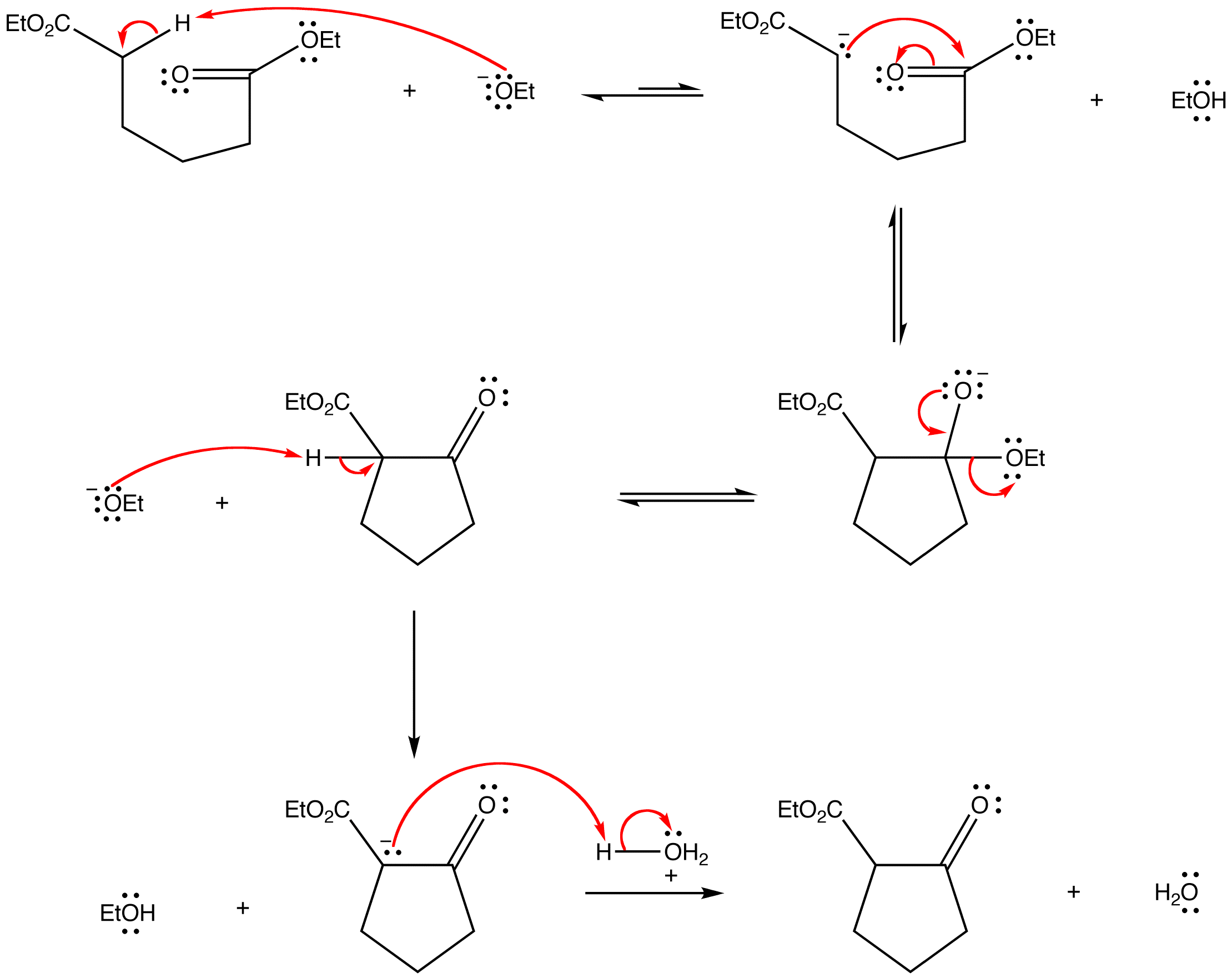22.6: 22.4 Claisen Condensation Reactions
- Page ID
- 149120
\( \newcommand{\vecs}[1]{\overset { \scriptstyle \rightharpoonup} {\mathbf{#1}} } \)
\( \newcommand{\vecd}[1]{\overset{-\!-\!\rightharpoonup}{\vphantom{a}\smash {#1}}} \)
\( \newcommand{\id}{\mathrm{id}}\) \( \newcommand{\Span}{\mathrm{span}}\)
( \newcommand{\kernel}{\mathrm{null}\,}\) \( \newcommand{\range}{\mathrm{range}\,}\)
\( \newcommand{\RealPart}{\mathrm{Re}}\) \( \newcommand{\ImaginaryPart}{\mathrm{Im}}\)
\( \newcommand{\Argument}{\mathrm{Arg}}\) \( \newcommand{\norm}[1]{\| #1 \|}\)
\( \newcommand{\inner}[2]{\langle #1, #2 \rangle}\)
\( \newcommand{\Span}{\mathrm{span}}\)
\( \newcommand{\id}{\mathrm{id}}\)
\( \newcommand{\Span}{\mathrm{span}}\)
\( \newcommand{\kernel}{\mathrm{null}\,}\)
\( \newcommand{\range}{\mathrm{range}\,}\)
\( \newcommand{\RealPart}{\mathrm{Re}}\)
\( \newcommand{\ImaginaryPart}{\mathrm{Im}}\)
\( \newcommand{\Argument}{\mathrm{Arg}}\)
\( \newcommand{\norm}[1]{\| #1 \|}\)
\( \newcommand{\inner}[2]{\langle #1, #2 \rangle}\)
\( \newcommand{\Span}{\mathrm{span}}\) \( \newcommand{\AA}{\unicode[.8,0]{x212B}}\)
\( \newcommand{\vectorA}[1]{\vec{#1}} % arrow\)
\( \newcommand{\vectorAt}[1]{\vec{\text{#1}}} % arrow\)
\( \newcommand{\vectorB}[1]{\overset { \scriptstyle \rightharpoonup} {\mathbf{#1}} } \)
\( \newcommand{\vectorC}[1]{\textbf{#1}} \)
\( \newcommand{\vectorD}[1]{\overrightarrow{#1}} \)
\( \newcommand{\vectorDt}[1]{\overrightarrow{\text{#1}}} \)
\( \newcommand{\vectE}[1]{\overset{-\!-\!\rightharpoonup}{\vphantom{a}\smash{\mathbf {#1}}}} \)
\( \newcommand{\vecs}[1]{\overset { \scriptstyle \rightharpoonup} {\mathbf{#1}} } \)
\( \newcommand{\vecd}[1]{\overset{-\!-\!\rightharpoonup}{\vphantom{a}\smash {#1}}} \)
Objectives
After completing this section, you should be able to
- write an equation to illustrate a Claisen condensation reaction.
- write a detailed mechanism for a Claisen condensation reaction or its reverse.
- identify the product formed in a given Claisen condensation reaction.
- identify the ester and other reagents needed to form a given β‑keto ester by a Claisen condensation reaction.
Key Terms
- Claisen condensation reaction
Study Notes
You have already seen that ethyl acetoacetate‑type compounds are very useful in organic syntheses. Any reaction which results in the formation of these compounds will also be of importance. In the next section, you will see how the range of β‑keto esters that can be prepared by this method is extended through the use of two different esters as starting materials.
Because esters can contain α hydrogens they can undergo a condensation reaction similar to the aldol reaction called a Claisen Condensation. In a fashion similar to the aldol, one ester acts as a nucleophile while a second ester acts as the electrophile. During the reaction a new carbon-carbon bond is formed. The product is a β-keto ester. A major difference with the aldol reaction is the fact that hydroxide cannot be used as a base because it could possibly react with the ester. Instead, an alkoxide version of the alcohol used to synthesize the ester is used to prevent transesterification side products.
Claisen Condensation
Going from reactants to products simply
Example 23.7.1: Claisen Condensation
Claisen Condensation Mechanism
1) Enolate formation
2) Nucleophilic attack
3) Removal of leaving group
Contributors
Dr. Dietmar Kennepohl FCIC (Professor of Chemistry, Athabasca University)
Prof. Steven Farmer (Sonoma State University)
OBJECTIVES
After completing this section, you should be able to
- write an equation to illustrate a mixed Claisen condensation.
- identify the structural features that should be present in the two esters if a mixed Claisen condensation is to be successful.
- determine whether a given pair of esters is likely to produce a good yield of a single product when subjected to a mixed Claisen condensation.
- identify the product formed when a given pair of esters is used in a mixed Claisen condensation.
- identify the esters that should be used to produce a given β‑keto ester by a mixed Claisen condensation.
- write an equation to illustrate the formation of a β‑diketone through a mixed Claisen‑type condensation between an ester and a ketone.
- identify the β‑diketone formed as the result of a mixed Claisen‑type condensation between a given ester and a given ketone.
- identify the reagents necessary to synthesize a given β‑diketone by a mixed Claisen‑type condensation between an ester and a ketone.
- write detailed mechanisms for mixed Claisen reactions and reactions that are related to the mixed Claisen reaction, including those in which both reacting moieties are present in the same compound.
-
STUDY NOTES
Just as we can react together two different aldehydes or ketones in a mixed aldol condensation, so can we react together two different esters in a mixed (or “crossed”) Claisen condensation. Again, by carefully selecting our substrates we can obtain a good yield of the desired product and minimize the number of possible by‑products. Note that even if we replace one of the esters with a ketone, the reaction is still referred to as Claisen condensation. The important thing to realize as you study these reactions is that they all take place by essentially the same mechanism—attack by an enolate anion on a carbonyl group.
Crossed Claisen Condensation
Claisen condensations between different ester reactants are called Crossed Claisen reactions. Crossed Claisen reactions in which both reactants can serve as donors and acceptors generally give complex mixtures. Because of this most Crossed Claisen reactions are usually not performed unless one reactant has no alpha hydrogens.

EXAMPLE 23.8.1: CROSSED CLAISEN CONDENSATION
OBJECTIVES
After completing this section, you should be able to
- write an equation to illustrate an internal Claisen condensation, that is, a Dieckmann cyclization.
- identify the product formed when a 1,6‑ or 1,7‑diester undergoes an internal Claisen condensation.
- identify the diester needed to prepare a given cyclic β‑keto ester by an internal Claisen condensation.
- identify the structural features present in a diester that lead to the formation of more than one product in an internal Claisen condensation.
-
KEY TERMS
- Dieckmann cyclization
-
Mechanism

STUDY NOTES
Essentially no new material is introduced in this section; Dieckmann cyclizations are intramolecular Claisen condensations. These reactions occur for 1,6‑ and 1,7‑diesters, as these substances result in the formation of compounds containing five‑ and six‑membered rings, respectively. You may recall that the formation of such ring systems is favoured because they are relatively free of strain.
Dieckmann Condensation
A diester can undergo an intramolecular reaction called a Dieckmann condensation.
EXAMPLE 23.9.1: DIECKMAN CONDENSATION



